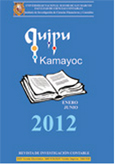QUALITY MODELS IN THE REGULATORY FRAMEWORK FOR THE ACCREDITATION OF THE UNIVERSITIES OF PERU
DOI:
https://doi.org/10.15381/quipu.v20i37.4014Keywords:
Calidad, modelos de calidad, Universidad Peruana, formación profesional, acreditación de carreras universitarias, SINEACE, CONEAU, administración universitaria.Abstract
This article is the result of a brief exploratory investigation of the relationship between quality models proposed by the administrative doctrine and the national accreditation process of Peruvian universities. The Peruvian university, reflecting on the political, social, cultural and technological changes in our society, is also experiencing a process of change, for example, a major expansion in university departments, modalities and number of students. However, this expansion process, often unplanned, has created serious doubts and questions about whether the expansion is ensuring the quality of professional training, research and social outreach. It must also be consistent with the social demands of the market and national development. To meet this need, we have promoted a system of accreditation of the quality of university education through the creation of a National Assessment, Accreditation and Certification of Educational Quality (SINEACE), was prepared in 2003 by the General Law of Education, 28044. They want to know if the quality models proposed in the accreditation standards of the system are consistent with organization doctrinal trends.
Downloads
Downloads
Published
Issue
Section
License
Copyright (c) 2012 Adrian Alejandro Flores Konja, Manuel Alberto Hidalgo Tupia

This work is licensed under a Creative Commons Attribution-NonCommercial-ShareAlike 4.0 International License.
AUTHORS RETAIN THEIR RIGHTS:
a. Authors retain their trade mark rights and patent, and also on any process or procedure described in the article.
b. Authors retain their right to share, copy, distribute, perform and publicly communicate their article (eg, to place their article in an institutional repository or publish it in a book), with an acknowledgment of its initial publication in Quipukamayoc .
c. Authors retain theirs right to make a subsequent publication of their work, to use the article or any part thereof (eg a compilation of his papers, lecture notes, thesis, or a book), always indicating the source of publication (the originator of the work, journal, volume, number and date).






